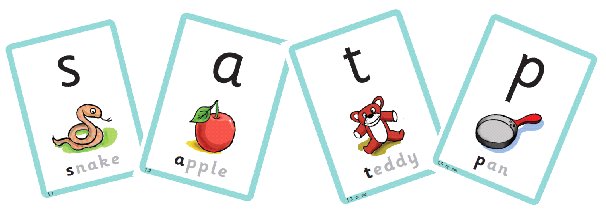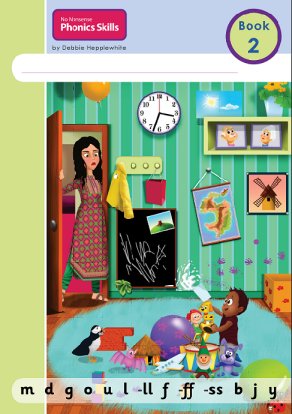


Ways you can support your children at home: talking and listening.
The word 'phonics' comes from the ancient Greek word for 'sound'.
The English language is a mix of many languages from Anglo Saxon, North German, French and Latin. It is therefore not straightforward or easy to learn as the link between sounds of speech and letters is very complicated. Phonics is a way of teaching children how to read and write. It helps children hear, identify and use different sounds that distinguish one word from another in the English language.
Written language can be compared to a code, so knowing the sounds of individual letters and how those letters sound when they are combined will help children decode words as they read.
Understanding phonics will also help children know which letters to use when they are writing words.
Phonics involves matching the sounds of spoken English with individual letters or groups of letters. For example, the sound k can be spelled as c, k, ck or ch.
Teaching children to blend the sounds of letters together helps them decode unfamiliar or unknown words by sounding them out. For example, when a child is taught the sounds for the letters t, p, a and s, they can start to build up the words: “tap”, “taps”, “pat”, “pats” and “sat”.
Introducing young children to the joy and wonder of books requires a systematic teaching of phonics.
When our children enter Early Years they take part in high-quality phonics sessions every day. In Nursery, these are focused on storytelling, singing nursery rhymes and playing with sounds and rhythm. Teachers plan activities that will help children to listen attentively to sounds around them, such as the sounds of their toys and to sounds in spoken language. Teachers teach a wide range of nursery rhymes and songs. They read good books to and with the children. This helps to increase the number of words they know – their vocabulary – and helps them talk confidently about books.
As the children move into Reception, they learn to match sounds to letters and use their phonic knowledge for reading and writing activities and in their independent play. Early handwriting is taught as part of the multi-sensory approach to phonics teaching. Hear the sound, say the sound, write the letter shape or letter group.
The aim of this booklet is to give you a clear picture of how we approach the teaching of phonics and word recognition and how, as a parent or carer, you can support and encourage your child at home.

Your child should be supported whatever their rate of learning. There is a very close link between difficulty with phonics and hearing so, if your child is making progress more slowly than might be expected, it would be worth having their hearing checked.
From a very early stage, children develop awareness of different sounds in spoken language. They develop understanding that spoken words are made up of different sounds (phonemes) and they learn to match these phonemes to letters (graphemes). Phonics is about children knowing how letters link to sounds (graphemes to phonemes), for example, c as in ‘cat’, ll as in ‘fell’, ee as in ‘sheep’.
Children use this phonic knowledge when they are reading and writing. This approach has been shown to provide a quick and efficient way for most young children to learn to read words on the page, fluently and accurately. We want children to develop this skill so that it becomes automatic. This also greatly helps them with their spelling.

Learners are taught at ‘word level’ at first – and then they apply their knowledge and skills to sentences and texts – and reading books and texts which match the code knowledge taught to date. The focus is on learning to ‘break the code’ which is why there are no pictures in texts aimed at learning a particular phonics skill. This way, children learn to apply their growing phonics knowledge and skills to cumulative words, sentences and texts for reading, spelling and writing. Alongside phonics texts, your child will also receive cumulative, decodable reading books in addition to the phonics programme. (cumulative = words which ‘match’ the alphabetic code taught to date)
The children read from and work in bright and engaging workbooks where they see the code they are learning and they practise writing it. They take part in lots of different activities and games to help them hear the sound and match it to the code. They then practice reading a story with the new code in it. This story is also taken home so you can listen to your child independently reading the new code.

Learning to read is tricky! Simply put, learning to read consists of two main processes – both of which are necessary. We need to teach children how to read (or ‘decode’) the words they are reading, but they also need to have the understanding of language to know what the words mean (comprehension).
Therefore, the more spoken language that the children know, the better – as this supports reading. There is nothing better than talk, talk, talk. Please chatter about anything and everything with your children. This will help build up your child’s stock of words and knowledge and understanding of the world – talk will improve comprehension and this will help the ability to read.
We firmly believe that the importance of a reading culture both at school and in the home is cannot be over-emphasised. Reading with your child and to your child is a fun and important thing to do to children of all primary ages. Thousands of new words are learned from books to expand our vocabulary. Books also: - entertain, - create interests, - open a window on the world (knowledge, empathy, understanding, morals), - fire up imaginations, etc.

When we teach early reading and spelling, we don’t use the alphabet’s letter names (ay, bee, see…) but we use the sounds; /a/ (as in ‘apple’ or ‘Annie’); /b/ (as in ‘bat’ or ‘Ben’); /k/ (as in ‘cat’ or ‘car’) and so on. We have clips on our website which model how to pronounce the sounds we teach.
Letters and letter groups are the alphabetic code for the sounds in our speech. Decoding the letter symbols into sounds is the basis for reading: the child sees the printed word ‘soap’, decodes the sounds /s/ /oa/ /p/ (not - /suh/ /oa/ /puh/!) and then blends the sounds to read “soap”.
Sometimes letters (graphemes) need to be decoded with different sounds, depending on the actual word e.g. ‘a’ could be /a/ as in ‘apple’; /ar/ as in ‘father’; /ai/ as in ‘angel’; /o/ as in ‘want’.
At other times one sound is represented by more than one letter: /ay/ in ‘eight’. The sound /or/ can be written as: or, aw, our, au, al, oar, oor, ore, augh, ough, (w)ar, (qu)ar~, (w)a~. Sometimes the same letter group has more than one sound: ‘ea’ as in eat or bread. Because the system is so complex, we need to teach the children their phonics in tiny systematic steps and not everything at once!
The alphabetic code is a reversible code, which means that we can start with the sound and encode to print (for spelling/writing) or we start with the print and decode to sound (for reading). In our phonics lessons we always include both ways.
Home reading books will match this code so the children can practise at home. The children will also bring home a Together Time book which is not to be read aloud by your child. This is to be shared together to develop a love of longer stories and give time to talk about characters and events in the book.










As you can see, our alphabetic code is very complex which is why when children practise both at school and at home - it becomes a lot easier!
Firstly, please take an interest in your child’s phonics work. It is so helpful to practise your child’s phonics text or book with them. Give your child plenty of praise for his or her reading or work whatever the level of the knowledge and skill of the child.
Please share your Together Time with your child and talk about the story. Reading books aloud to your child and sharing the reading of books with your child are also important. Please continue to hear your child read aloud, even when he or she can read independently and chatter about everything.
Your child’s teacher will always be available if you have any questions or would like more information about how phonics is taught in school. There is also lots of information on our website about how to help your child at home, including websites, leaflets and games. Simply click the Home Learning icon.